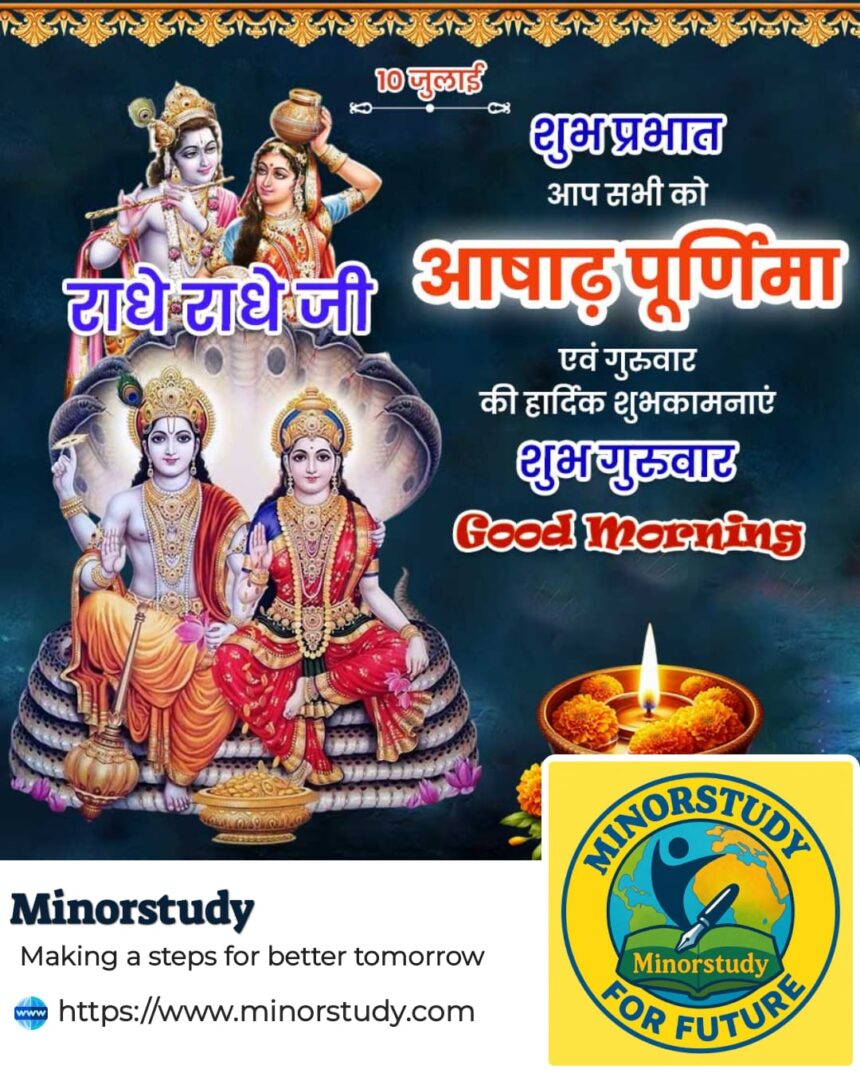Discover the history, spiritual importance, timeline, and daily life impact of Ashadh Purnima — a day that marks the Buddha’s first sermon and Guru Purnima across traditions.
🌼 Introduction: What is Ashadh Purnima?
Ashadh Purnima, also known as Guru Purnima in the Hindu tradition and Dhamma Day in Buddhism, is a sacred full moon day observed in the Hindu month of Ashadha (June–July). It is revered across India and Southeast Asia by Buddhists, Hindus, and spiritual seekers.
- 🌼 Introduction: What is Ashadh Purnima?
- 🕰️ Timeline of Ashadh Purnima
- 🧠 7 Fascinating Facts About Ashadh Purnima
- 🧭 Historical and Spiritual Significance
- 🌏 Observance and Rituals Across Traditions
- 🧩 Why Ashadh Purnima Matters in Our Lives
- 1. Spiritual Realignment
- 2. Cultural Continuity
- 3. Importance of Gratitude
- 4. Moral Foundation
- 5. Community Bonding
- 🙋 Frequently Asked Questions (FAQs)
- Q1: What is the main message of Ashadh Purnima?
- Q2: Is Ashadh Purnima the same as Guru Purnima?
- Q3: Why is Sarnath important on Ashadh Purnima?
- Q4: Can anyone celebrate Ashadh Purnima?
- Q5: What is Chaturmas, and why does it start on this day?
- 🧘 Important Points to Remember
- 💌 Wishing Messages for Ashadh Purnima
- 🧘♀️ Daily Life Impacts of Celebrating Ashadh Purnima
- 📘 Conclusion: Why We Need Ashadh Purnima Today
Ashadh Purnima is primarily celebrated to honor and express gratitude to spiritual teachers (Gurus). For Buddhists, it commemorates the day Lord Buddha delivered his first sermon at Sarnath, setting the Dhammachakra (Wheel of Dharma) in motion.
It is a spiritually energizing day — a time of reflection, reverence, and renewal — that encourages people to reconnect with inner truth, ethical living, and guidance from wise teachers.
🕰️ Timeline of Ashadh Purnima
| Year/Period | Event |
|---|---|
| 6th Century BCE | Lord Buddha delivers his first sermon at Sarnath after attaining enlightenment. |
| Vedic Era | Ashadh Purnima observed as Guru Purnima — a day to honor Sage Vyasa and all spiritual teachers. |
| Ancient India | Buddhist monks begin Chaturmas (four-month monsoon retreat) from Ashadh Purnima. |
| Modern Times | Celebrated by Hindus, Buddhists, Jains, and various spiritual communities worldwide. |
| UN Recognition | It is associated with Dhamma Day, celebrated globally by Buddhist communities. |
🧠 7 Fascinating Facts About Ashadh Purnima
📜 On this day, Gautama Buddha gave his first sermon to the five ascetics (Pañcavaggiya) at Deer Park, Sarnath.
🧘♂️ The sermon titled Dhammacakkappavattana Sutta marks the official beginning of Buddhism as a teaching tradition.
🙏 In Hinduism, it is observed as Guru Purnima, a day dedicated to Sage Vyasa, the compiler of the Vedas and author of the Mahabharata.
🌀 It signifies the turning of the wheel of Dharma and spiritual awakening.
🌧️ It also marks the beginning of the Chaturmas, the four-month monsoon retreat for monks and ascetics.
🏞️ Sarnath, where Buddha gave his sermon, becomes a major pilgrimage site on this day.
🌍 Celebrated across India, Nepal, Sri Lanka, Thailand, and Myanmar with great reverence and devotion.
🧭 Historical and Spiritual Significance
✨ In Buddhism:
Ashadh Purnima is the day when the Buddha became a teacher. After attaining enlightenment under the Bodhi tree at Bodh Gaya, he traveled to Sarnath, where he taught the Four Noble Truths and the Eightfold Path for the first time. This “First Turning of the Wheel of Dharma” is considered one of the most sacred events in the Buddhist tradition.
✨ In Hinduism:
The full moon of Ashadh is observed as Guru Purnima, honoring Sage Vyasa, the Adi Guru (original teacher). Disciples express gratitude to their Gurus — spiritual, academic, or personal — who have guided them on the path of knowledge and self-realization.
🌏 Observance and Rituals Across Traditions
🧘 Buddhist Observance:
Pilgrimages to Sarnath or local viharas (monasteries).
Recitation of the Dhammacakkappavattana Sutta.
Offerings of flowers, incense, and lamps at Buddha statues.
Meditation sessions, sermons by senior monks, and ethical reflections.
Start of Chaturmas – monks stay in one place for the rainy season and teach Dhamma.
🙏 Hindu Observance:
Puja (ritual worship) of Gurus or spiritual teachers.
Offering Dakshina (gifts or donations) to honor teachers.
Scripture readings, especially from the Mahabharata and Vedas.
Fasting or feasting, depending on regional tradition.
Celebrated with enthusiasm in ashrams, temples, schools, and universities.
🧩 Why Ashadh Purnima Matters in Our Lives
1. Spiritual Realignment
It offers a powerful pause — a time to reflect on our spiritual path, behaviors, and ethics.
2. Cultural Continuity
Ashadh Purnima is intergenerational. It connects us with ancient teachings and reaffirms our place in cultural and spiritual history.
3. Importance of Gratitude
The day emphasizes the practice of gratitude towards our Gurus, which enhances humility, receptiveness, and growth.
4. Moral Foundation
The teachings delivered on this day — such as the Middle Way and Eightfold Path — provide a framework for ethical living in a complex world.
5. Community Bonding
Celebrating the day with fellow seekers, students, or sangha members builds unity and shared purpose.
🙋 Frequently Asked Questions (FAQs)
Q1: What is the main message of Ashadh Purnima?
To honor one’s Guru, live by ethical principles, and remember the start of spiritual teachings by great masters like Buddha and Vyasa.
Q2: Is Ashadh Purnima the same as Guru Purnima?
Yes, in the Hindu context, it is called Guru Purnima. In the Buddhist context, it is Dhamma Day or Ashadha Purnima.
Q3: Why is Sarnath important on Ashadh Purnima?
Sarnath is where Lord Buddha gave his first sermon, beginning the global Buddhist movement.
Q4: Can anyone celebrate Ashadh Purnima?
Absolutely. You don’t have to be a monk or religious follower. Anyone can reflect, express gratitude to teachers, or take ethical resolutions on this day.
Q5: What is Chaturmas, and why does it start on this day?
Chaturmas is the four-month monsoon retreat observed by monks. It begins on Ashadh Purnima and is a time of deep learning, teaching, and introspection.
🧘 Important Points to Remember
It’s a day of transformation, reverence, and ethical reflection.
Celebrated by both Buddhists and Hindus, symbolizing interfaith harmony.
Marks the beginning of teaching traditions in both spiritual paths.
Encourages self-discipline, gratitude, and humility.
Its values are timeless and apply to every human seeking growth.
💌 Wishing Messages for Ashadh Purnima
🪔 “May the light of wisdom and the blessings of your Guru illuminate your path always. Happy Ashadh Purnima!”
🌕 “On this sacred Ashadh Purnima, may the wheel of Dharma continue to turn in your heart. Walk the path of truth and compassion.”
🙏 “Wishing you a spiritually rich and enlightening Ashadh Purnima. May you always find guidance, peace, and clarity.”
🧘♀️ Daily Life Impacts of Celebrating Ashadh Purnima
Cultivates mindfulness and gratitude in everyday interactions.
Enhances emotional intelligence through honoring others.
Inspires people to lead more disciplined and moral lives.
Encourages learning from mentors, elders, and spiritual guides.
Promotes mental clarity and peace, essential in modern chaos.
Reinvigorates cultural and spiritual literacy in families and communities.
📘 Conclusion: Why We Need Ashadh Purnima Today
In an age of noise, distractions, and ego, Ashadh Purnima invites us to pause and bow — to our teachers, our conscience, and the eternal truths that guide humanity. It celebrates the beginning of Dhamma, the power of knowledge, and the importance of gratitude.
More than just a full moon or a festival, Ashadh Purnima is a reminder of our better selves — the part of us that seeks truth, uplifts others, and walks the path of inner peace.
By observing this sacred day, we tap into the wisdom of the ages and carry it forward — with compassion, clarity, and courage.
🌕 “Celebrate wisdom, honor your teachers, and walk the path of light this Ashadh Purnima. A day to bow, learn, and grow. #AshadhPurnima #GuruPurnima #DhammaDay #BuddhaWisdom”








